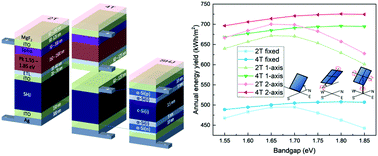Predicting and optimising the energy yield of perovskite-on-silicon tandem solar cells under real world conditions†
Abstract
Metal halide perovskite absorber materials have emerged as a potential new technology for large-scale low-cost photovoltaic solar power. One great advantage lies in the ability to tune their light absorption band across the visible to near infrared spectral regions, making it an ideal candidate for tandem solar cell applications, in combination with traditional crystalline silicon. For a multi-junction solar cell to operate at peak efficiency, the current generation in all junctions must closely match, especially for monolithically integrated tandem architectures. It is feasible to achieve such matching under a standardized solar spectrum with direct illumination. However, under real world conditions the spectrum of sun light, and the fraction of diffuse to direct sun light varies considerably depending upon the location and weather conditions. Hence, it is not directly obvious how much more efficient a multi-junction solar cell needs to be, in comparison to a single junction cell, before it will produce more electrical power under real world conditions. Here, we introduce a rigorous optical and device simulation to optimize perovskite-on-silicon tandem solar cells and identify feasibility of various optimisation parameters to achieve the highest possible efficiencies. Firstly, we determine that the ideal bandgap for a perovskite “top-cell” is 1.65 eV, which will deliver up to 32% efficiency when combined with a silicon rear cell. Furthermore, we calculate the annual energy yield under hourly spectrum changes at different locations and optimize the stack to show that tandem solar cells are yielding up to 30% more energy output than the single junction silicon. Most critically, the standardized air mass 1.5 efficiency measurement improvements observed for the tandems cells, translate almost entirely to the same fractional improvement in energy yield. Hence, the efficiency of the tandem cell is not significantly “de-rated” by real world spectral variations. We do observe however, that tandem solar cell stacks can deliver further improvements by optimising differently depending on the location of installation. Our results justify the drive towards monolithically integrated multi-junction solar cells, and will enable guidance to design the ideal perovskite tandem device and allow estimations for energy yield and hence the levelized cost of electricity.

- This article is part of the themed collection: 2017 Energy and Environmental Science HOT articles


 Please wait while we load your content...
Please wait while we load your content...